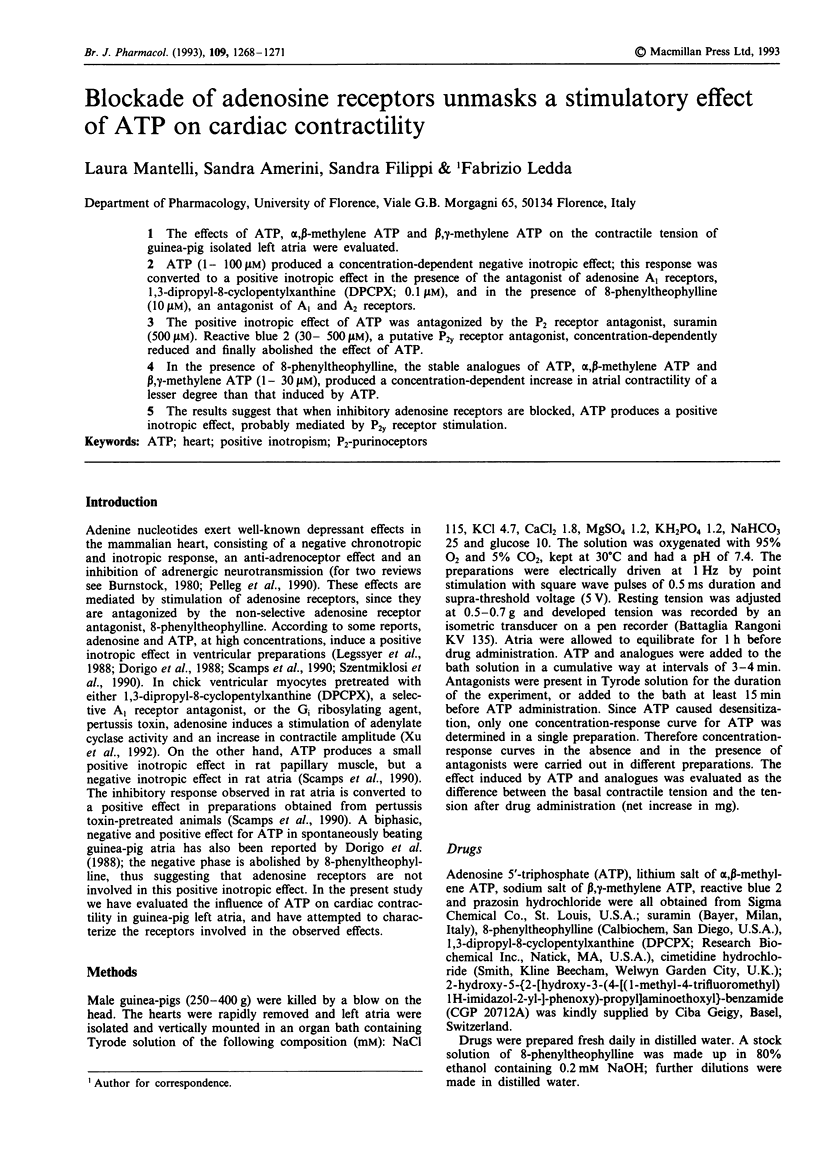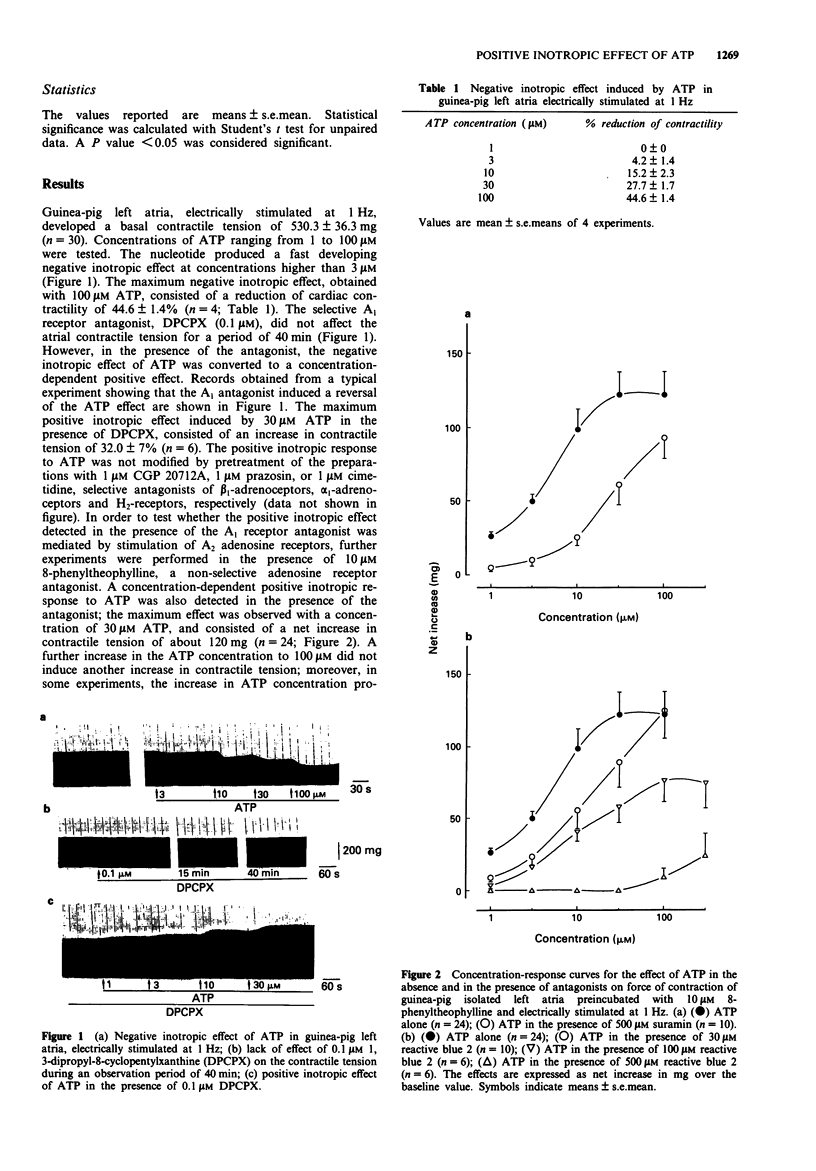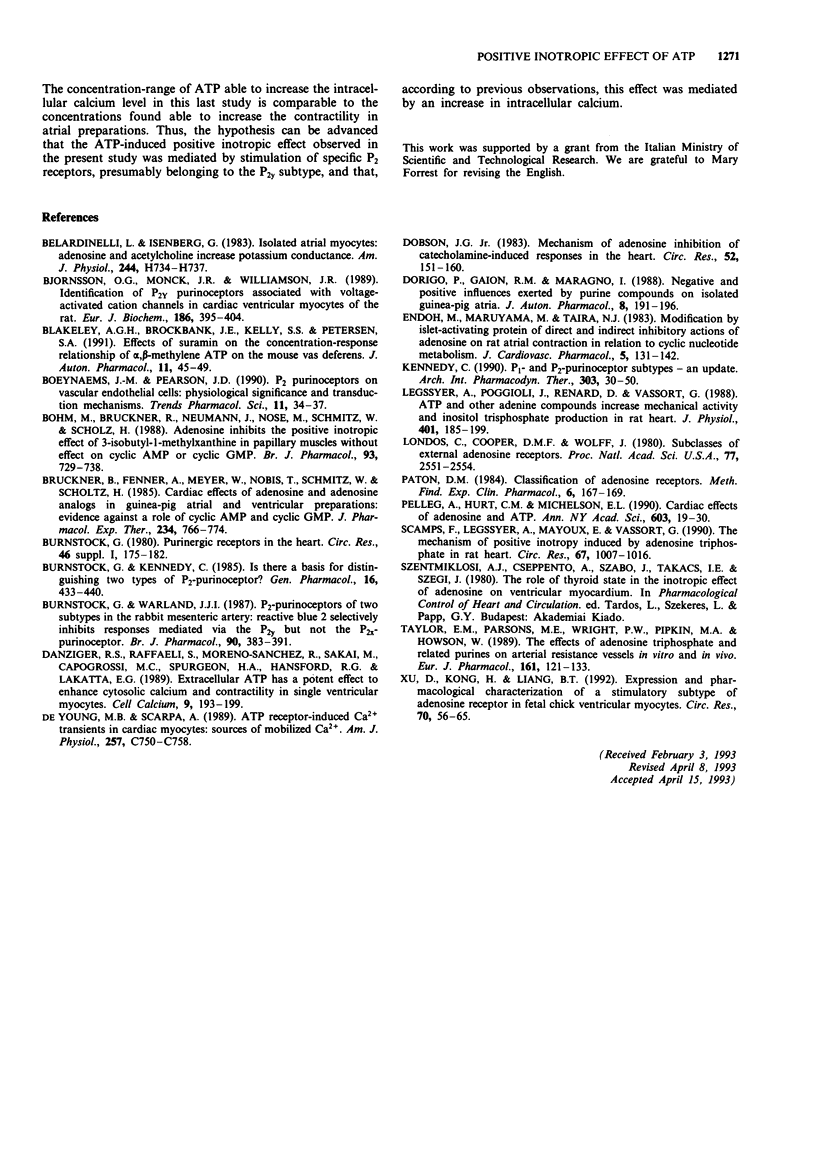Abstract
1. The effects of ATP, alpha,beta-methylene ATP and beta,gamma-methylene ATP on the contractile tension of guinea-pig isolated left atria were evaluated. 2. ATP (1-100 microM) produced a concentration-dependent negative inotropic effect; this response was converted to a positive inotropic effect in the presence of the antagonist of adenosine A1 receptors, 1,3-dipropyl-8-cyclopentylxanthine (DPCPX; 0.1 microM), and in the presence of 8-phenyltheophylline (10 microM), an antagonist of A1 and A2 receptors. 3. The positive inotropic effect of ATP was antagonized by the P2 receptor antagonist, suramin (500 microM). Reactive blue 2 (30-500 microM), a putative P2y receptor antagonist, concentration-dependently reduced and finally abolished the effect of ATP. 4. In the presence of 8-phenyltheophylline, the stable analogues of ATP, alpha,beta-methylene ATP and beta,gamma-methylene ATP (1-30 microM), produced a concentration-dependent increase in atrial contractility of a lesser degree than that induced by ATP. 5. The results suggest that when inhibitory adenosine receptors are blocked, ATP produces a positive inotropic effect, probably mediated by P2y receptor stimulation.
Full text
PDF



Selected References
These references are in PubMed. This may not be the complete list of references from this article.
- Belardinelli L., Isenberg G. Isolated atrial myocytes: adenosine and acetylcholine increase potassium conductance. Am J Physiol. 1983 May;244(5):H734–H737. doi: 10.1152/ajpheart.1983.244.5.H734. [DOI] [PubMed] [Google Scholar]
- Björnsson O. G., Monck J. R., Williamson J. R. Identification of P2Y purinoceptors associated with voltage-activated cation channels in cardiac ventricular myocytes of the rat. Eur J Biochem. 1989 Dec 8;186(1-2):395–404. doi: 10.1111/j.1432-1033.1989.tb15222.x. [DOI] [PubMed] [Google Scholar]
- Blakeley A. G., Brockbank J. E., Kelly S. S., Petersen S. A. Effects of suramin on the concentration--response relationship of alpha, beta-methylene ATP on the mouse vas deferens. J Auton Pharmacol. 1991 Feb;11(1):45–49. doi: 10.1111/j.1474-8673.1991.tb00243.x. [DOI] [PubMed] [Google Scholar]
- Boeynaems J. M., Pearson J. D. P2 purinoceptors on vascular endothelial cells: physiological significance and transduction mechanisms. Trends Pharmacol Sci. 1990 Jan;11(1):34–37. doi: 10.1016/0165-6147(90)90039-b. [DOI] [PubMed] [Google Scholar]
- Brückner R., Fenner A., Meyer W., Nobis T. M., Schmitz W., Scholz H. Cardiac effects of adenosine and adenosine analogs in guinea-pig atrial and ventricular preparations: evidence against a role of cyclic AMP and cyclic GMP. J Pharmacol Exp Ther. 1985 Sep;234(3):766–774. [PubMed] [Google Scholar]
- Burnstock G., Kennedy C. Is there a basis for distinguishing two types of P2-purinoceptor? Gen Pharmacol. 1985;16(5):433–440. doi: 10.1016/0306-3623(85)90001-1. [DOI] [PubMed] [Google Scholar]
- Burnstock G., Warland J. J. P2-purinoceptors of two subtypes in the rabbit mesenteric artery: reactive blue 2 selectively inhibits responses mediated via the P2y-but not the P2x-purinoceptor. Br J Pharmacol. 1987 Feb;90(2):383–391. doi: 10.1111/j.1476-5381.1987.tb08968.x. [DOI] [PMC free article] [PubMed] [Google Scholar]
- Böhm M., Brückner R., Neumann J., Nose M., Schmitz W., Scholz H. Adenosine inhibits the positive inotropic effect of 3-isobutyl-1-methylxanthine in papillary muscles without effect on cyclic AMP or cyclic GMP. Br J Pharmacol. 1988 Apr;93(4):729–738. doi: 10.1111/j.1476-5381.1988.tb11456.x. [DOI] [PMC free article] [PubMed] [Google Scholar]
- Danziger R. S., Raffaeli S., Moreno-Sanchez R., Sakai M., Capogrossi M. C., Spurgeon H. A., Hansford R. G., Lakatta E. G. Extracellular ATP has a potent effect to enhance cytosolic calcium and contractility in single ventricular myocytes. Cell Calcium. 1988 Aug;9(4):193–199. doi: 10.1016/0143-4160(88)90023-1. [DOI] [PubMed] [Google Scholar]
- De Young M. B., Scarpa A. ATP receptor-induced Ca2+ transients in cardiac myocytes: sources of mobilized Ca2+. Am J Physiol. 1989 Oct;257(4 Pt 1):C750–C758. doi: 10.1152/ajpcell.1989.257.4.C750. [DOI] [PubMed] [Google Scholar]
- Dobson J. G., Jr Mechanism of adenosine inhibition of catecholamine-induced responses in heart. Circ Res. 1983 Feb;52(2):151–160. doi: 10.1161/01.res.52.2.151. [DOI] [PubMed] [Google Scholar]
- Dorigo P., Gaion R. M., Maragno I. Negative and positive influences exerted by purine compounds on isolated guinea-pig atria. J Auton Pharmacol. 1988 Sep;8(3):191–196. doi: 10.1111/j.1474-8673.1988.tb00182.x. [DOI] [PubMed] [Google Scholar]
- Endoh M., Maruyama M., Taira N. Modification by islet-activating protein of direct and indirect inhibitory actions of adenosine on rat atrial contraction in relation to cyclic nucleotide metabolism. J Cardiovasc Pharmacol. 1983 Jan-Feb;5(1):131–142. doi: 10.1097/00005344-198301000-00021. [DOI] [PubMed] [Google Scholar]
- Kennedy C. P1- and P2-purinoceptor subtypes--an update. Arch Int Pharmacodyn Ther. 1990 Jan-Feb;303:30–50. [PubMed] [Google Scholar]
- Legssyer A., Poggioli J., Renard D., Vassort G. ATP and other adenine compounds increase mechanical activity and inositol trisphosphate production in rat heart. J Physiol. 1988 Jul;401:185–199. doi: 10.1113/jphysiol.1988.sp017157. [DOI] [PMC free article] [PubMed] [Google Scholar]
- Londos C., Cooper D. M., Wolff J. Subclasses of external adenosine receptors. Proc Natl Acad Sci U S A. 1980 May;77(5):2551–2554. doi: 10.1073/pnas.77.5.2551. [DOI] [PMC free article] [PubMed] [Google Scholar]
- Paton D. M. Classification of adenosine receptors. Methods Find Exp Clin Pharmacol. 1984 Apr;6(4):167–169. [PubMed] [Google Scholar]
- Pelleg A., Hurt C. M., Michelson E. L. Cardiac effects of adenosine and ATP. Ann N Y Acad Sci. 1990;603:19–30. doi: 10.1111/j.1749-6632.1990.tb37658.x. [DOI] [PubMed] [Google Scholar]
- Scamps F., Legssyer A., Mayoux E., Vassort G. The mechanism of positive inotropy induced by adenosine triphosphate in rat heart. Circ Res. 1990 Oct;67(4):1007–1016. doi: 10.1161/01.res.67.4.1007. [DOI] [PubMed] [Google Scholar]
- Taylor E. M., Parsons M. E., Wright P. W., Pipkin M. A., Howson W. The effects of adenosine triphosphate and related purines on arterial resistance vessels in vitro and in vivo. Eur J Pharmacol. 1989 Feb 28;161(2-3):121–133. doi: 10.1016/0014-2999(89)90834-0. [DOI] [PubMed] [Google Scholar]
- Xu D., Kong H. Y., Liang B. T. Expression and pharmacological characterization of a stimulatory subtype of adenosine receptor in fetal chick ventricular myocytes. Circ Res. 1992 Jan;70(1):56–65. doi: 10.1161/01.res.70.1.56. [DOI] [PubMed] [Google Scholar]


